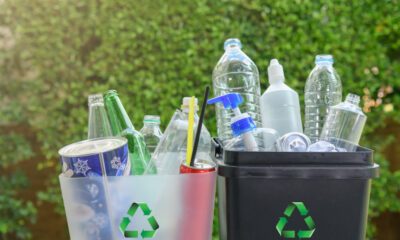

Features
How Can Businesses Shed Their Single-Use Plastics?
Fixing the climate problems that face the world is no mean feat. Sometimes it can feel like every bit of good that we do is eradicated by the damage caused by big business. A 2017 study discovered that 100 companies were responsible for 71% of global emissions, highlighting how much impact these large organizations have.
However, NASA says, “it may not be too late to avoid or limit some of the worst effects of climate change.” So, if we all keep doing our bit and making changes where possible we can help protect the planet.
This leads us to how businesses can positively contribute to the fight against climate change. Let’s take a look at how businesses can shed single-use plastics from their operations to help reverse the damage caused to our environment.
Start by hunting for plastic
The best way to start reducing your single-use plastic consumption is to go on the hunt for it within your business. You may be surprised at how much plastic is in everyday items. But, if you don’t know there is plastic in something, you won’t know how to remove it.
What we’re suggesting is essentially a plastics audit of everything your business produces and uses. You can find where the single-use plastics are and start thinking about the best ways to reduce or remove them. This can do a lot to help protect our oceans, as well as save the vegetation and animals around us.
“Almost 50% of all plastic is single-use plastic, and almost all single-use plastic is unnecessary”, reports Plastic Free Communities. They add, “Only 9% of plastic gets recycled and 10 million tonnes of it ends up in our oceans every year”.
This process isn’t always about removing plastics completely, though. For instance, you may be able to switch from a single-use printer ink cartridge to a reusable one. If every business were to switch in this way, the difference would be immense.
According to Statista, there were approximately 213.65 million companies worldwide in 2020. That’s an awful lot of plastics that could be saved by making one simple switch, but why stop there?
Design with reuse in mind
If your business involves making a physical product then consider retracing your steps back to the design stage. Reducing your single-use plastics can begin with transforming your product using alternative materials. However, it’s important to remember that reusable and durable materials need to withstand washing and sterilization.
Plastics are lurking everywhere and some of the common but often unknown places they are found include:
- Metal cans – which are often lined with plastic
- Wrapping paper – often a mix of plant fibres and laminated plastic
- Drinks cartons – typically about 20% plastic and 80% paper
- Food packaging
- Personal care products – commonly come in plastic tubes
- Feminine hygiene products – the average disposable sanitary napkin contains two grams of plastic
Fortunately, there are plenty of alternatives to plastics that you can design your product with.
Examples of these include:
- Stainless steel – great for food or beverage storage
- Glass – easily recycled or repurposed
- Wood – a renewable resource that can replace plastic in many instances
- Bamboo – is similar to wood and grows at a rapid rate
- Paper – recyclable and compostable when no longer of use
Switch to biodegradable materials
Not every product can be easily reused, but for such situations, it’s possible to use biodegradable materials instead. For instance, beer companies like the Saltwater Brewery, have switched to seaweed six-pack rings to hold their cans or bottles.
They are plastic-free, biodegradable and edible for animals that may come into contact with them along the refuse process. Yes, they are still single-use but they are much kinder to the planet and won’t stick around for decades or even centuries once discarded. By contrast, plastic bottles take up to 450 years to decompose in landfill.
Other examples of biodegradable packaging materials include:
- Pressed hay – which is being used as egg cartons
- Mushroom packaging – combining mushroom root and agricultural waste to become a compostable product to replace styrofoam packaging
- Banana leaves – a solution to a devastating plastic packaging problem in Thailand to replace it with banana and bamboo packaging
Join a sustainable initiative
Just one business reducing its single-use plastics can have a significant impact on the environment but there is still more that can be done. Finding an inventive solution to reduce or remove your single-use plastics should be celebrated and shared, but not all businesses think like this yet.
Research by Brita discovered, “22% of businesses say they are responsible for being a leader in reducing single-use plastics and 73% indicated it is not their responsibility to share best practice terms of plastic waste prevention with others in their sector”.
This indicates that some businesses would rather keep their solutions to themselves than share with competitors. Fortunately, there are initiatives like the European Plastics Pact which brings together frontrunner companies and governments to make a difference. Joining initiatives like these can act as a motivator for your company to keep up with the latest solutions to reducing our plastics consumption.
Think ‘New Plastics Economy’
Another prominent initiative encouraging a reduction in plastics is the New Plastics Economy being championed by the Ellen MacArthur Foundation.
The circular economy looks at every stage of a product’s journey following three actions:
- Eliminate
- Innovate
- Circulate
These three actions look to eliminate all unnecessary plastic and innovate to ensure that any plastics we do need are reusable, recyclable or compostable. Finally, all of the plastic items we continue using after the first two actions must remain in use and out of the environment.
“Since the launch of the New Plastics Economy Global Commitment by the Ellen MacArthur Foundation in October 2018, common single-use plastic items such as straws, carrier bags and black carbon plastics are being eliminated by 70% of relevant business signatories while 80% are eliminating PVC from packaging”.
Demand more from your suppliers
Finally, you can demand more from your suppliers to tackle single-use plastics. Just like your customers may have started to expect your business to reduce or remove single-use plastics, you can demand it of your suppliers.
Public awareness of plastic consumption is growing, forcing more businesses to shed their single-use plastics. If you find that your suppliers aren’t able to change, consider alternatives that are offering a single-use-free product or service.
After all, continuing to use single-use plastics in an ever-more aware economy could hinder how customers view your brand. As the consensus of plastic use grows in favor of removing or reducing, businesses of all types are going to have to consider where their products and services factor into the conversation.
Shedding single-use plastics
Rome wasn’t built in a day and it’s not going to be a quick fix to remove single-use plastics from your business. However, it is possible to begin implementing small changes and reductions in plastic consumption. Over time, these replacements will see your business operating without unnecessary single-use plastics.






























